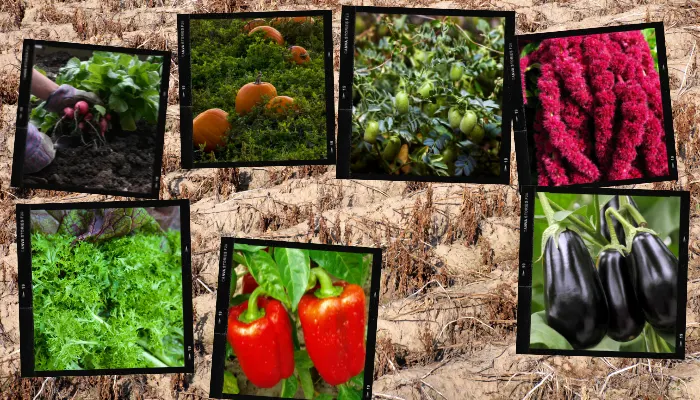We live in unusual times. Climate change has proven itself to be a legitimate threat to crops, and life, around the globe, melting glaciers at alarming rates and threatening entire species. The backyard gardener isn’t immune! With this undeniable global warming, it’s more important than ever to grow vegetables that can withstand dry spells.
You have two choices: irresponsibly water your veggies or pivot with a drought-resistant vegetable garden. These hardy crops laugh in the face of water restrictions and still deliver bountiful harvests and plenty to fill your table.
Dive into our list of the 21 best drought-resistant vegetables to make your garden resilient, productive and climate friendly.
1. Tomatoes
Tomatoes aren’t just garden staples; they’re drought warriors. Cherry, Roma, and even Beefsteak varieties can thrive with less water once established. Think sun-soaked flavors packed into every juicy bite. Loaded with vitamins C and K, folate, and antioxidants, tomatoes support immune health and reduce inflammation.
2. Zucchini
Zucchini, the ultimate garden overachiever, loves basking in the sun. Its deep roots make it a pro at finding water deep below the soil surface. Rich in vitamins A and C, zucchini promotes healthy skin and vision, while its high fiber content aids digestion.
3. Peppers
Whether you prefer them sweet or spicy, peppers are your go-to. These vibrant veggies can handle the heat, literally and figuratively, thriving in drought conditions with minimal fuss. Packed with vitamins A and C, peppers boost immune function and improve eye health.
4. Eggplant
Eggplants, with their glossy, purple skins, are Mediterranean natives accustomed to dry conditions. Plant them and watch them flourish with minimal watering. High in fiber and antioxidants, eggplants help manage blood sugar levels and combat oxidative stress. Plus, combine eggplant with some kangaroo, and you have a very tasty, healthy meal!

5. Okra
Okra, often overlooked, is a heat-loving, drought-tolerant powerhouse. Its unique pods bring a taste of the South to your kitchen, even in the driest of summers. Rich in vitamins C and K, and folate, okra supports immune health and blood clotting.
6. Chickpeas
Chickpeas, or garbanzo beans, are more than just a hummus ingredient. These legumes thrive on neglect, needing little water to produce their nutrient-packed seeds. A great source of protein, fiber, and iron, chickpeas are excellent for muscle health and digestion.
7. Beans
From green beans to kidney beans, these legumes don’t demand much water. Their ability to fix nitrogen also enriches the soil, making them a double-win for your garden. Beans are high in protein, fiber, and several key vitamins and minerals, supporting heart health and blood sugar regulation.
8. Amaranth

This ancient grain is a drought-tolerant gem. Both its leaves and seeds are edible, providing versatile nutrition with minimal water. Amaranth is rich in protein, fiber, and essential amino acids, promoting muscle growth and digestive health.
9. Sweet Potatoes
Sweet potatoes, with their sprawling vines, dig deep for water, ensuring a steady crop even when rain is scarce. Plus, they’re packed with vitamins and flavor. Loaded with vitamins A and C, sweet potatoes support eye health and boost the immune system.
10. Swiss Chard
Swiss chard’s vibrant stalks and leaves aren’t just pretty; they’re tough. This leafy green can handle heat and drought, making it a reliable addition to any garden. Rich in vitamins K, A, and C, Swiss chard helps maintain strong bones and healthy skin.
11. Spinach
While it might seem delicate, spinach can be surprisingly drought-resistant, especially varieties like Malabar spinach, which thrives in hot, dry conditions. High in iron, calcium, and vitamins A and C, spinach is essential for strong bones and overall health.
12. Collard Greens
Collard greens are Southern classics for a reason. These leafy greens stand up to heat and lack of water, providing nutritious leaves all season long. Packed with vitamins K and A, collard greens support bone health and immune function.
13. Beets
Beets, both the roots and greens, are champions in drought conditions. Their deep roots search out moisture, making them a reliable crop. Rich in folate, iron, and antioxidants, beets help improve blood flow and lower blood pressure.
14. Carrots
Carrots are root vegetables that dive deep into the soil to find water. They’re a crunchy, sweet addition to your drought-resistant garden. High in beta-carotene, carrots support eye health and provide a good source of fiber.
15. Radishes
Radishes mature quickly and need little water. They’re perfect for impatient gardeners looking for fast, reliable results. Radishes are rich in vitamin C and potassium, which support immune function and heart health.
16. Garlic
Garlic’s tough nature makes it a drought-resistant favorite. Plant it once, and it will thrive with minimal attention, warding off pests and adding flavor to your meals. Garlic is packed with allicin, which has potent medicinal properties, including anti-inflammatory and immune-boosting effects.
17. Onions
Onions are another bulb vegetable that thrives in dry conditions. Their pungent, flavorful bulbs are a testament to their resilience. Rich in antioxidants and vitamin C, onions help boost the immune system and improve heart health.
18. Pumpkins
Pumpkins aren’t just for Halloween. These sprawling vines thrive in hot, dry climates, producing hearty, nutritious gourds with minimal water. Pumpkins are loaded with vitamins A and C, which support eye health and immune function.
19. Kale
Kale isn’t just a superfood; it’s a super plant. Its tough leaves can withstand drought, providing nutritious greens throughout the growing season. High in vitamins K, A, and C, kale supports bone health, vision, and the immune system.
20. Mustard Greens
Mustard greens add a peppery kick to your dishes and are incredibly drought-tolerant. These greens can handle heat and dry conditions with ease. Rich in vitamins K, A, and C, mustard greens promote healthy skin and bones and boost the immune system.
21. Artichokes
Artichokes are perennial plants that thrive in dry conditions. Their spiky leaves and delicious hearts make them a unique, drought-resistant addition to your garden. Artichokes are high in fiber, vitamins C and K, and folate, which support digestive health and immune function.
Final Thoughts Worth Reading (Humility Is Not My Strength)
So, there you have it, 21 of the best drought-resistant vegetable plants ready to transform your garden into a resilient paradise. But here’s the kicker: adopting these hardy heroes isn’t just about ensuring your veggie patch survives a dry spell. It’s about making a savvy, sustainable choice that saves you time, money, and effort.
Did you know that traditional gardening can consume up to 30% of a household’s water usage? By opting for drought-resistant varieties, you slash that number significantly. Not only do you help conserve precious water, but you also cut down on those dreaded water bills. Plus, less watering means more time to sit back, relax, and enjoy your garden.
Imagine strolling through your garden on a scorching summer day, the sun beating down, and seeing your tomatoes, peppers, and kale standing tall and proud. These plants are the true underdogs of the gardening world, often overlooked but always ready to impress. They don’t just survive; they thrive with a kind of grit that would make Rocky Balboa proud.
And let’s face it, who wouldn’t want a garden that’s as tough as nails? You get the bragging rights of having a lush, productive garden even when Mother Nature decides to turn up the heat. So, why not embrace these drought-defying champions and give your garden the resilience it deserves?
Remember, gardening isn’t just about what you grow, but how you grow it. By choosing drought-resistant vegetables, you’re not just cultivating food; you’re fostering a more sustainable and eco-friendly future. Now, go ahead and plant those seeds. Your future self (and your water bill) will thank you!
















